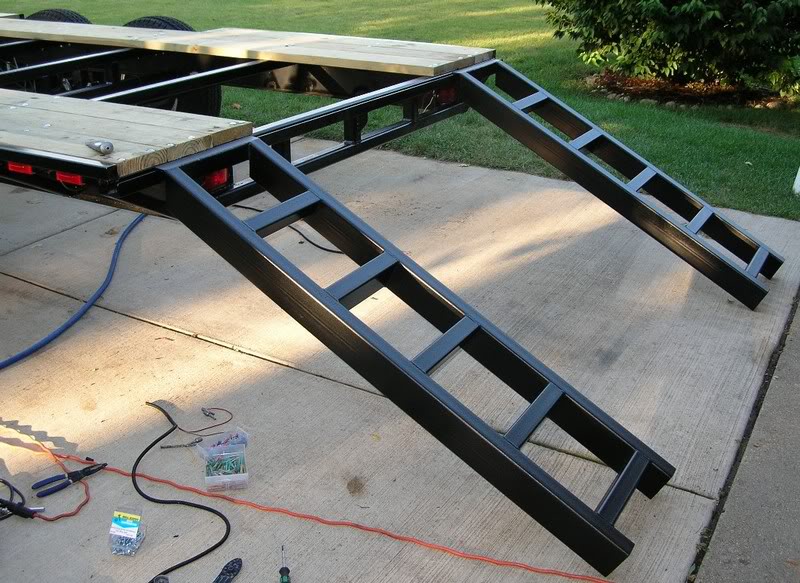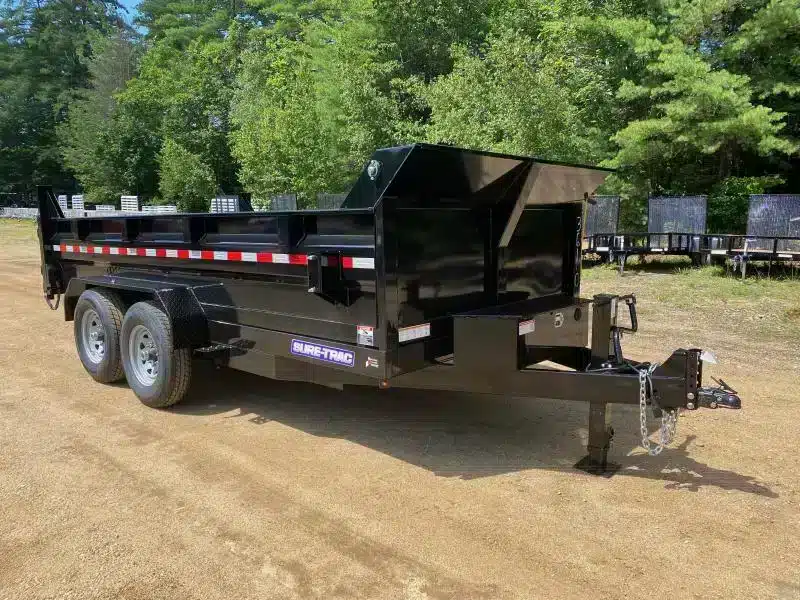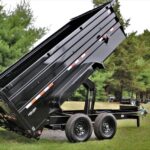Trailer ramps act as indispensable tools for transporting heavy equipment, vehicles, and goods onto trailers effortlessly and safely. But with so many types, sizes, and options available, it can be daunting to navigate the world of trailer ramps. In this blog post, we will explore everything you need to know about trailer ramps, from their diverse applications and required lengths, to heavy-duty options and utility trailer ramps. Whether you’re in search of replacement ramps, interested in DIY solutions, or looking for semi-trailer ramps, we’ve got you covered with expert advice and recommendations. So let’s dive in and discover the perfect trailer ramps for your hauling needs!
How Long Should a Trailer Ramp be?
Trailer ramps are essential accessories for anyone who uses trailers to transport heavy equipment or vehicles. They provide a safe and convenient way to load and unload cargo, minimizing the risk of accidents or damage. One important consideration when choosing a trailer ramp is its length. The length of a trailer ramp can vary depending on the type of trailer and the specific needs of the user. In this blog post, we will explore the factors to consider when determining the ideal length for a trailer ramp and provide some guidance on finding the perfect fit for your needs.

1. Type of Trailer:
The first factor to consider when determining the length of a trailer ramp is the type of trailer it will be used with. Different trailers have different designs and dimensions, and this can affect the required length of the ramp. For example, a utility trailer for hauling landscaping equipment may have different requirements compared to a semi-trailer for transporting heavy machinery. It’s important to consider the dimensions and weight capacity of your trailer to ensure the ramp is the right length for safe and efficient loading and unloading.
2. Load Angle:
Another important factor to consider when determining the length of a trailer ramp is the desired load angle. The load angle is the angle created between the ground and the ramp when fully extended. A steeper load angle means a shorter ramp, while a shallower load angle requires a longer ramp. The load angle can impact the ease of loading and unloading as well as the clearance required for the cargo. It’s important to strike a balance between a safe load angle and the available space for maneuvering the trailer and cargo.
3. Cargo Height:
The height of the cargo being loaded onto the trailer also plays a role in determining the ideal length of the ramp. If you frequently transport vehicles or equipment with varying heights, it’s crucial to choose a ramp that can accommodate the tallest load without compromising safety. Additionally, considering the clearance needed for loading taller cargo is essential, as insufficient clearance can lead to damage or accidents during the loading and unloading process.
In conclusion, choosing the right length for a trailer ramp depends on several factors, including the type of trailer, load angle, and cargo height. It’s important to carefully consider these factors to ensure the ramp is suitable for your specific needs. By taking the time to select the appropriate length, you can ensure safe and efficient loading and unloading of your cargo, while minimizing the risk of accidents or damage. Whether you opt for a heavy-duty, utility, or DIY trailer ramp, remember to always prioritize safety and choose a ramp that meets your requirements.
What are loading ramps used for?
Loading ramps are a crucial tool when it comes to transporting heavy equipment, machinery, or vehicles onto trailers. They provide a safe and efficient means of loading and unloading, making the process much easier and reducing the risk of injury. Trailer ramps are typically made from durable materials such as aluminum or steel, which are strong enough to withstand heavy loads. They come in various sizes and designs, each suited for different types of loading needs.
One common use of loading ramps is for loading vehicles onto trailers. Whether you own a car hauling business or simply need to transport your own vehicle, trailer ramps provide an inclined surface that allows vehicles to be driven or rolled onto the trailer. This eliminates the need for lifting or pushing vehicles onto the trailer, reducing strain on the body and preventing damage to the vehicle or trailer.

Utility trailer ramps are another type of loading ramp that are specifically designed for use with utility trailers. These ramps are typically wider and longer, allowing for easy loading of various types of equipment, such as ATVs, motorcycles, or lawn care equipment. They often feature non-slip surfaces or traction strips to ensure the safety of both the operator and the equipment being loaded.
- One important consideration when using loading ramps is their length. The length of the ramp determines the angle of incline and the ease of loading. Trailer ramps should be long enough to provide a gradual incline rather than a steep slope. This allows for smoother loading and reduces the risk of equipment or vehicles bottoming out.
- Semi-trailer ramps, on the other hand, are designed for use with semi-trailers, which are much higher off the ground compared to regular trailers. These ramps are typically longer and have a higher weight capacity to accommodate the larger size and weight of semi-trucks and their cargo.
| Types of Loading Ramps | Uses |
|---|---|
| Trailer Ramps | For loading vehicles onto trailers |
| Utility Trailer Ramps | For loading various equipment onto utility trailers |
| Semi-trailer Ramps | For loading cargo onto high-sided semi-trailers |
| Replacement Trailer Ramps | For replacing damaged or worn-out ramps |
| DIY Trailer Ramps | For building customized ramps based on specific needs |
In conclusion, loading ramps play a vital role in the transportation industry by providing a safe and efficient means of loading heavy equipment or vehicles onto trailers. Whether it’s for hauling vehicles, transporting equipment, or moving machinery, trailer ramps are an indispensable tool that ensures the smooth and secure loading and unloading of cargo.
Trailer Ramps Heavy Duty
Trailer ramps are essential for safely loading and unloading heavy equipment, vehicles, and cargo onto trailers. To ensure maximum safety and efficiency, it is important to choose the right type of ramp for your specific needs. One popular option is heavy-duty trailer ramps, which are designed to withstand heavier loads and provide added stability.
Heavy-duty trailer ramps are typically made from high-quality materials such as steel or aluminum, which are known for their durability and strength. These ramps are specifically engineered to handle heavier loads and can typically support weights of up to several thousand pounds. This makes them ideal for industrial applications, construction sites, and transportation of heavy machinery or vehicles.
One of the key factors to consider when selecting heavy-duty trailer ramps is the length. The length of the ramp will depend on the type and size of the vehicles or equipment you plan to load onto the trailer. It is important to choose a ramp that is long enough to provide a gradual incline and ensure a safe and smooth transition onto the trailer.
- Trailer Ramp Length: The length of heavy-duty ramps can vary, ranging from 6 feet to 16 feet or more. It is recommended to choose a ramp length that is at least 1.5 times the height of the trailer deck to ensure a safe loading angle.
- Ramp Weight Capacity: Heavy-duty trailer ramps are designed to handle higher weight capacities compared to standard ramps. The weight capacity can range from 5,000 pounds to 25,000 pounds or even more, depending on the ramp’s construction and design.
- Ramp Design: Heavy-duty ramps often feature design elements such as anti-slip surfaces, built-in traction plates, and raised side rails for added safety and stability during loading and unloading operations.
In addition to their durability and weight capacity, heavy-duty trailer ramps are also known for their portability and easy storage. Many ramps are designed to be foldable, allowing for compact storage when not in use. This makes them convenient for transportation and ensures they take up minimal space in your workshop or garage.
Benefits of Heavy-Duty Trailer Ramps:
| 1. Enhanced safety and stability during loading and unloading operations. |
| 2. Ability to handle heavier loads and equipment. |
| 3. Durable construction for long-lasting use. |
| 4. Portable and easy to store. |
| 5. Suitable for industrial applications and heavy-duty transportation needs. |
Whether you are a contractor, truck driver, or simply a DIY enthusiast, heavy-duty trailer ramps are a valuable investment for safe and efficient loading and unloading. By carefully considering factors such as ramp length, weight capacity, and design, you can choose the ideal ramps to meet your specific requirements. So, next time you are in need of loading heavy equipment or vehicles onto a trailer, consider investing in heavy-duty trailer ramps for a reliable and secure hauling experience.
Utility Trailer Ramps
Utility trailer ramps are essential for safely loading and unloading heavy equipment or goods onto a utility trailer. Whether you’re a landscaper transporting lawn care equipment or a DIY enthusiast moving heavy machinery, having the right utility trailer ramps can make all the difference.

How long should a trailer ramp be?
When it comes to utility trailer ramps, one of the most important considerations is their length. The length of the ramp will depend on several factors, including the height of the trailer and the equipment being loaded. Generally, trailer ramps should be long enough to provide a gradual incline for smooth loading and unloading. A good rule of thumb is to have ramps that are at least one foot in length for every inch of height difference between the ground and the trailer bed.
What are loading ramps used for?
Utility trailer ramps, also known as loading ramps, serve the purpose of providing a safe and convenient means of loading and unloading heavy items onto a trailer. They are commonly used in various industries such as construction, agriculture, landscaping, and transportation. Loading ramps are designed to withstand heavy loads and provide a stable platform for equipment, vehicles, or goods to be securely moved onto the trailer.
Trailer ramps heavy duty
When it comes to heavy-duty applications, it is crucial to choose utility trailer ramps that are built to withstand the weight and stress of heavy loads. Heavy-duty trailer ramps are typically constructed from durable materials such as aluminum or steel, which offer excellent strength and stability. These ramps often feature reinforced mounting brackets or support beams to ensure maximum load-bearing capacity and safety during loading and unloading.
DIY trailer ramps
If you’re a DIY enthusiast or someone who prefers to build things on your own, you can create your own utility trailer ramps. Building DIY trailer ramps allows you to customize the design and specifications based on your specific needs. However, it is important to ensure that your homemade ramps are sturdy, secure, and capable of bearing the weight of the intended load. Proper construction techniques and the use of high-quality materials are vital to ensure safety when using DIY trailer ramps.
Replacement trailer ramps
Over time, trailer ramps can become worn out or damaged due to frequent use and exposure to harsh weather conditions. In such cases, it becomes necessary to replace the old ramps with new ones to ensure safe loading and unloading operations. Replacement trailer ramps are available in various sizes, designs, and materials to suit different types of utility trailers. When replacing trailer ramps, it is important to choose ramps that are compatible with your trailer’s dimensions and weight capacity.
Semi-trailer ramps
For those dealing with larger and heavier equipment or vehicles, semi-trailer ramps are specifically designed to handle the weight and size of semi-trailers. These ramps are typically longer and wider than standard utility trailer ramps, providing a safer and more gradual incline for loading and unloading larger machinery, vehicles, or cargo. Semi-trailer ramps are built to withstand heavy loads and are often constructed from heavy-duty materials such as steel.
Replacement Trailer Ramps
Replacement Trailer Ramps are an essential component for any trailer owner. Over time, ramps may become worn out or damaged due to regular use. It is important to replace these ramps to ensure the safety and functionality of your trailer. When it comes to choosing replacement ramps, there are several factors to consider.

First, you need to determine the appropriate size of the replacement ramp. The length of the ramp is crucial as it determines the angle of incline, which in turn affects the ease of loading and unloading. A ramp that is too short may result in a steep incline, making it challenging to load heavy equipment. On the other hand, a ramp that is too long may require excessive space and make it difficult to position the trailer properly.
Additionally, the weight capacity of the replacement ramp is another important consideration. Different trailers have varying weight capacities, and it is crucial to choose a ramp that can support the maximum weight that your trailer may carry. It is advisable to select a ramp with a weight capacity that exceeds your trailer’s maximum load to ensure safety and durability.
Furthermore, the material of the replacement ramp should be taken into account. Ramps are commonly made from aluminum or steel, each having its own advantages. Aluminum ramps are lightweight, making them easy to handle and transport. They are also resistant to corrosion, which extends their lifespan. On the other hand, steel ramps are known for their high strength and durability, making them suitable for heavy-duty applications. The choice between aluminum and steel ramps depends on your specific needs and budget.
In conclusion, when it comes to replacement trailer ramps, it is crucial to consider factors such as size, weight capacity, and material. By choosing the right replacement ramps, you can ensure the safe and efficient loading and unloading of your trailer. Remember to measure the length of the ramp carefully, select a ramp with an adequate weight capacity, and choose the material that best suits your needs. By doing so, you can enjoy hassle-free and reliable trailer ramps for years to come.
DIY Trailer Ramps
DIY Trailer ramps are essential for loading and unloading various types of equipment and vehicles onto trailers. They provide a safe and efficient way to transport heavy items, such as motorcycles, ATVs, and lawnmowers. While you can purchase pre-made trailer ramps, building your own ramps can be a cost-effective and customizable solution. In this blog post, we will explore the benefits of DIY trailer ramps and provide you with some useful tips to create your own.

Benefits of DIY Trailer Ramps
There are several advantages to building your own trailer ramps. Firstly, it allows you to tailor the ramps to your specific needs. You can customize the width, length, and angle of the ramps to ensure a perfect fit for your trailer and the items you intend to load. Secondly, DIY trailer ramps can be significantly more affordable than purchasing pre-made ramps. By using readily available materials and simple construction techniques, you can save a considerable amount of money. Finally, building your own ramps can be a rewarding DIY project that allows you to gain new skills and knowledge in carpentry or metalworking.
Tips for Building DIY Trailer Ramps
- Measurements: Before starting your project, determine the length and width of the ramps you need. Consider the dimensions of your trailer and the items you will be loading.
- Materials: Choose suitable materials for your ramps. Some common options include wood, metal, or a combination of both. Consider the weight capacity and durability needed for your specific application.
- Construction: Depending on the materials chosen, you may need to cut and shape them accordingly. Secure the components together using screws, bolts, or welding, ensuring stability and strength.
- Surface: To enhance traction and prevent slipping, add a non-slip surface to your ramps. This can be achieved by attaching grip tape or applying an anti-slip coating.
- Test and Adjust: After completing the construction, test the ramps by loading and unloading your intended items. Make any necessary adjustments to ensure a safe and smooth loading process.
DIY trailer ramps offer a budget-friendly and customizable solution for loading and unloading equipment and vehicles onto trailers. By carefully planning your project and following the provided tips, you can create ramps that perfectly suit your needs. Building your own ramps not only saves you money but also allows you to gain valuable DIY skills. So why not embark on this rewarding project and enjoy the convenience and satisfaction of using ramps that you’ve created yourself? Happy ramp building!
Semi Trailer Ramps
Semi trailer ramps are essential equipment for loading and unloading heavy equipment onto semi trailers. These ramps are specifically designed to provide a safe and efficient way to bridge the gap between the ground and the trailer bed, allowing for easy loading and unloading processes. Whether you are a professional trucker or an individual looking to transport heavy machinery, having the right semi trailer ramp is crucial for a successful and hassle-free operation.
When considering semi trailer ramps, one important factor to take into account is the length of the ramp. The length of the ramp can vary depending on several factors such as the type of equipment being loaded, the height of the trailer bed, and the load capacity of the ramp. In general, the ramp should be long enough to provide a gradual incline to ensure a smooth and safe transition between the ground and the trailer bed.
Another important aspect to consider when choosing semi trailer ramps is their durability and weight capacity. These ramps should be constructed from heavy-duty materials such as aluminum or steel to withstand the weight of the equipment being loaded. Additionally, they should have a sufficient weight capacity to accommodate the heaviest loads. It is crucial to check the weight capacity of the ramp before purchasing to ensure it can handle your specific needs.
Factors to consider when choosing semi trailer ramps:
| Length: The ramp should be long enough to provide a gradual incline. |
| Material: Opt for ramps made from heavy-duty materials like aluminum or steel. |
| Weight Capacity: Ensure the ramp can handle the weight of your equipment. |
In addition to length and durability, it is also important to consider other features of semi trailer ramps, such as non-slip surfaces or traction aids. These features ensure that the equipment being loaded remains stable and secure during the loading and unloading process, reducing the risk of accidents or damage. Many ramps also come with safety features such as raised edges or attachment points to enhance stability and prevent any potential slips or falls.
Overall, semi trailer ramps play a vital role in the transportation of heavy equipment. They provide a safe and efficient way to load and unload items onto semi trailers, ensuring a smooth and hassle-free operation. By considering factors such as length, material, and weight capacity, as well as additional safety features, you can select the perfect semi trailer ramps to meet your specific needs and ensure a successful loading and unloading process.
Frequently Asked Questions
Here is another our content you may like to read: Trailer Light Kit 2023: Illuminate Your Journey with Safety and Style






